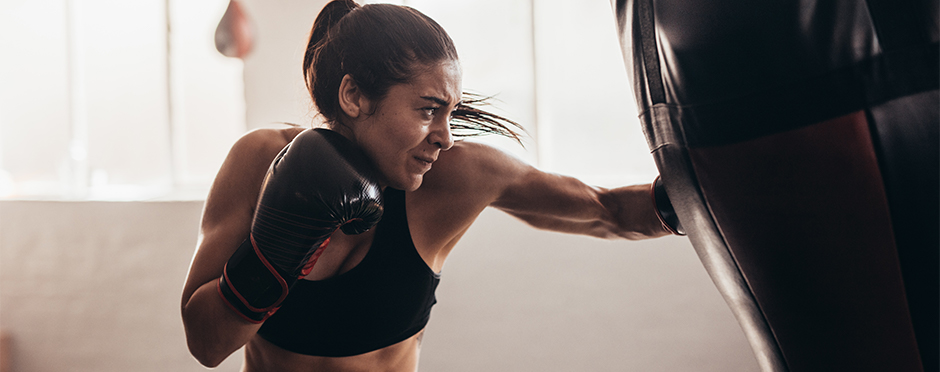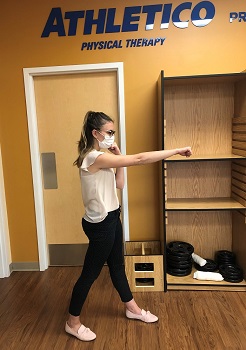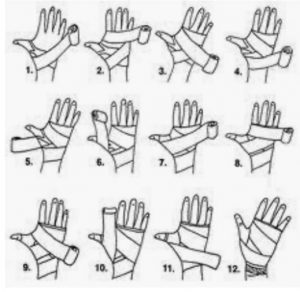
Knock Out Fun: Recreational Boxing Safety Tips
Leave a CommentAs people continue to focus on their health and find new ways to work out and exercise throughout the pandemic, some may turn to boxing. Whether a newcomer to boxing or an experienced veteran, we could all use a reminder on form and safety to decrease the risk of injury.
What Should a Punch Look Like?
When trying a new sport or class, movement mechanics are key. So, what should a punch look like? Punch mechanics vary greatly depending on what type of punch you are trying to perform. The easiest punch to master is the straight punch. With a straight punch, the athlete should stand with a staggered stance with their non-dominant hand in front. The driving force of the punch comes from the athlete’s core and ability to push off from their legs. Punching with just the arms can lead to pain and poor distribution of forces throughout the hand and arm. When hitting the punching bag, the wrist should be in neutral. This means that the wrist is not bent in either direction. Neutral wrists are able to deliver the most forces to the target. Practicing punches with a neutral wrist has also been found to improve punch velocity and decrease the risk of hand/wrist injuries.1
Why Should I Wrap My Hands?
If punching mechanics are good, why is it recommended to wrap my hands? Next to good mechanics, hand wraps are the second best way that an athlete can protect their hands while boxing. Properly wrapped hands can disperse forces, limiting the effect of a direct blow to the metacarpophalangeal joint (knuckles). It also limits the spread of the metacarpal bones which decreases the risk of fracture, sagittal band injuries or muscle tears of the intrinsic musculature. There are different techniques to wrapping the athlete’s hand before boxing. It is important to assess the anatomy of your hand and select a wrapping technique that best suits the athlete’s individual needs. Many gyms offer assistance with wraps and wrapping techniques to decrease injury.
Example of hand wrapping4
Types of Boxing Injuries
The hope is that all athletes and gym goers can participate in boxing without injuries but sometimes injuries will occur. It is important to know signs and symptoms of common boxing injuries as needed to get fast and effective care. Two common injuries affecting boxers include the boxer’s fracture and boxer’s knuckle.
- Boxer’s Fracture
- The boxer’s fracture is a fracture of the fifth metacarpal. The fifth metacarpal is the long bone of hand that sits right under the small finger. This injury most commonly occurs when direct trauma is applied to a clenched fist. Those that experience a boxer’s fracture typically experience pain on the back of the hand, edema, bruising and possible deformity.2
- Boxer’s Knuckle
- The second injury that can occur is the boxer’s knuckle. The boxer’s knuckle is an injury of the sagittal band. The sagittal band is a structure of the knuckle that stabilizes the tendon of the muscle that extends your fingers.3 It is believed that these injuries occur when an athlete hits a target with the narrow back edge of the index or long finger metacarpophalangeal joint (knuckle), instead of with the broad row of the clenched fingers. This injury can also happen with forced finger bending and wrist deviation regardless of the mechanism of injury, boxer’s knuckle results from poor punch mechanics. With these injuries, athletes often present with painful and swollen knuckles.3 Both boxer’s fractures and boxer’s knuckles should be evaluated and diagnosed by a medical professional.
If you are having pain or experiencing a hand injury following boxing (or any sport) please reach out to our team of Hand Therapists. Our highly trained hand therapists aim to improve your mobility and range of motion through effective treatment of conditions that affect your hands or upper extremities. Appointments are available both in-clinic and virtually through our Telehealth platform.
Find a Hand Therapist Near You
The Athletico blog is an educational resource written by Athletico employees. Athletico bloggers are licensed professionals who abide by the code of ethics outlined by their respective professional associations. The content published in blog posts represents the opinion of the individual author based on their expertise and experience. The content provided in this blog is for informational purposes only, does not constitute medical advice and should not be relied on for making personal health decisions.
References:
1. Walilko, T. J. (2005). Biomechanics of the head for Olympic boxer punches to the face. British Journal of Sports Medicine, 39(10), 710-719. doi:10.1136/bjsm.2004.014126
2. Malik, S., Herron, T., & Rosenberg, N. (2020). Fifth Metacarpal Fracture (Boxer’s Fracture). NCBI Bookshelf. doi:www.ncbi.nlm.nih.gov/books/NBK470428/
3. Kleinhenz, B. P., & Adams, B. D. (2015). Closed Sagittal Band Injury of the Metacarpophalangeal Joint. Journal of the American Academy of Orthopaedic Surgeons, 23(7), 415-423. doi:10.5435/jaaos-d-13-00203
4. “Hand Wrapping Instructions.” Alayasoma, 22 Sept. 2013, soma.alaya.net/?p=9967.


